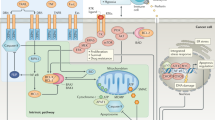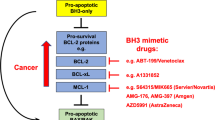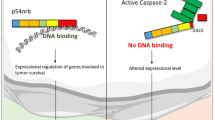Abstract
The inhibitor of apoptosis protein family has been characterized over the past 5 years, initially in baculovirus and more recently in metazoans. The IAPs are a widely expressed gene family of apoptotic inhibitors from both phylogenic and physiologic points of view. The diversity of triggers against which the IAPs suppress apoptosis is greater than that observed for any other family of apoptotic inhibitors including the bcl-2 family. The central mechanisms of IAP apoptotic suppression appear to be through direct caspase and pro-caspase inhibition (primarily caspase 3 and 7) and modulation of and by the transcription factor NF-κB. Although evidence for a direct oncogenic role for the IAPs has yet to be delineated, a number of lines of evidence point towards this class of protein playing a role in oncogenesis. The strongest evidence for IAP involvement in cancer is seen in the IAP called survivin. Although not observed in adult differentiated tissue, survivin is present in most transformed cell lines and cancers tested to date. Survivin has been shown to inhibit caspase directly and apoptosis in general, moreover survivin protein levels correlate inversely with 5 year survival rates in colorectal cancer. Recent data has also implicated survivin in cell cycle control. The second line of evidence for IAP involvement in cancer comes from their emerging role as mediators and regulators of the anti-apoptotic activity of v-Rel and NF-κB transcription factor families. The IAPs have been shown to be induced by NF-κB or v-Rel in multiple cell lines and conversely, HIAP1 and HIAP2 have been shown to activate NF-κB possibly forming a positive feed-back loop. Overall a picture consistent with an IAP role in tumour progression rather than tumour initiation is emerging making the IAPs an attractive therapeutic target.
This is a preview of subscription content, access via your institution
Access options
Subscribe to this journal
Receive 50 print issues and online access
$259.00 per year
only $5.18 per issue
Buy this article
- Purchase on Springer Link
- Instant access to full article PDF
Prices may be subject to local taxes which are calculated during checkout
Similar content being viewed by others
Author information
Authors and Affiliations
Rights and permissions
About this article
Cite this article
LaCasse, E., Baird, S., Korneluk, R. et al. The inhibitors of apoptosis (IAPs) and their emerging role in cancer. Oncogene 17, 3247–3259 (1998). https://doi.org/10.1038/sj.onc.1202569
Published:
Issue Date:
DOI: https://doi.org/10.1038/sj.onc.1202569
Keywords
This article is cited by
-
FAP is critical for ovarian cancer cell survival by sustaining NF-κB activation through recruitment of PRKDC in lipid rafts
Cancer Gene Therapy (2023)
-
BRD7 inhibits enhancer activity and expression of BIRC2 to suppress tumor growth and metastasis in nasopharyngeal carcinoma
Cell Death & Disease (2023)
-
Targeting survivin with Tanshinone IIA inhibits tumor growth and overcomes chemoresistance in colorectal cancer
Cell Death Discovery (2023)
-
Targeting Apoptosis in Cancer
Current Oncology Reports (2022)
-
Aging features of the migratory locust at physiological and transcriptional levels
BMC Genomics (2021)



